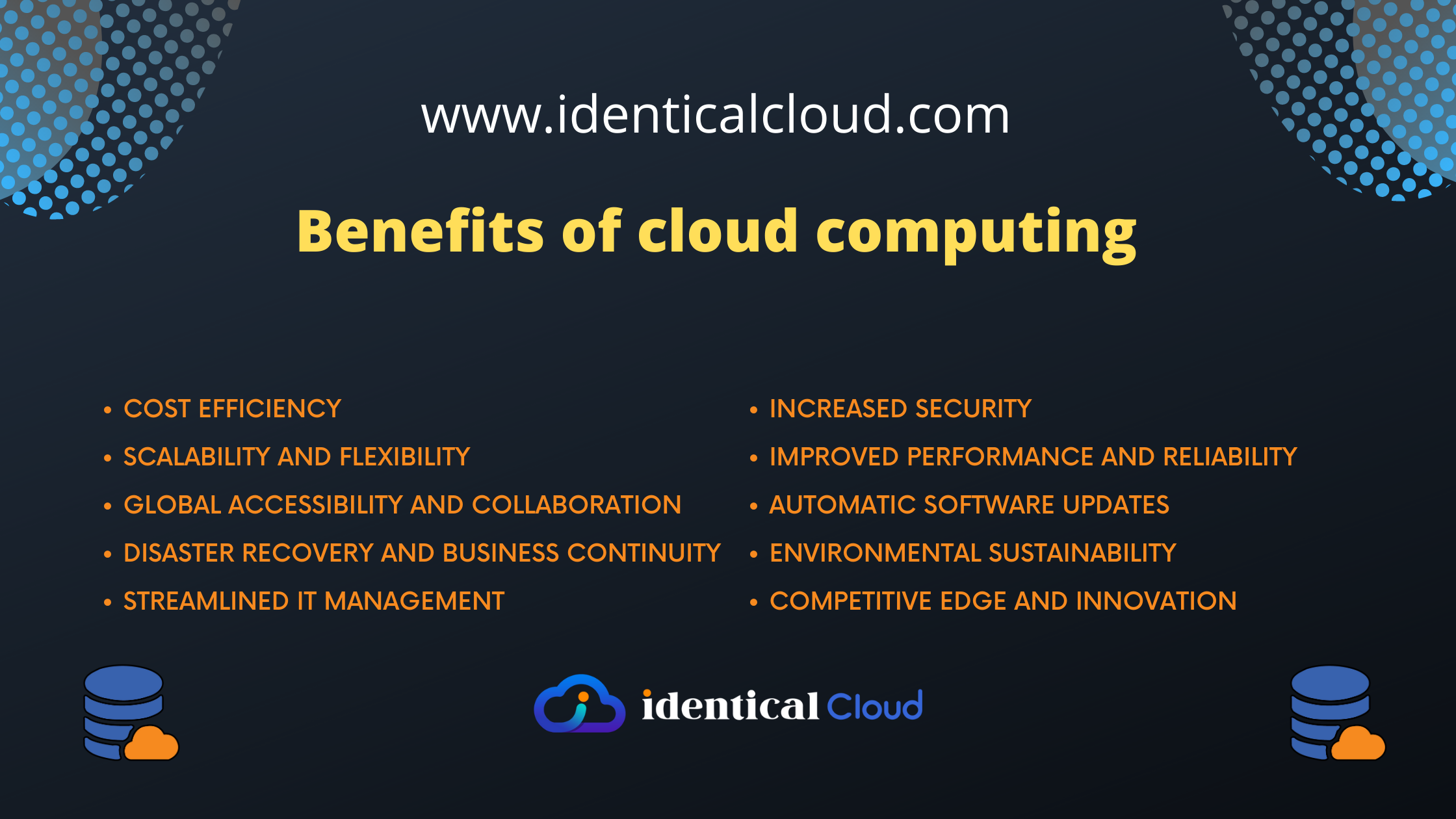
Benefits of cloud computing
Benefits of cloud computing
Cloud computing has revolutionized the way businesses and individuals store, access, and manage data and applications. By leveraging remote servers and the internet, cloud computing offers a range of benefits that have transformed the technology landscape. In this blog post, we will delve into the details and explore the numerous advantages of cloud computing, shedding light on how it has become an integral part of modern IT infrastructure.
Cost Efficiency
One of the primary benefits of cloud computing is its cost efficiency. Cloud services operate on a pay-as-you-go model, allowing businesses to avoid upfront infrastructure costs and only pay for the resources they use. By eliminating the need for on-premises hardware, maintenance, and infrastructure management, organizations can significantly reduce capital expenses. Additionally, the scalability of cloud resources enables businesses to easily scale up or down based on demand, optimizing resource utilization and reducing wastage.
Scalability and Flexibility
Cloud computing offers unparalleled scalability and flexibility. Businesses can quickly scale their resources up or down based on their requirements. Whether it’s handling a sudden surge in website traffic or accommodating increased data storage needs, the cloud provides on-demand scalability without the need for physical infrastructure upgrades. This flexibility empowers organizations to respond swiftly to market changes, improve agility, and adapt to evolving business needs.
Global Accessibility and Collaboration
Cloud computing enables seamless global accessibility and collaboration. With cloud-based services, data and applications are accessible from anywhere, anytime, as long as there is an internet connection. This accessibility breaks down geographical barriers and allows teams to work together remotely, fostering collaboration and increasing productivity. Real-time collaboration tools, such as cloud-based document editing and file sharing, facilitate efficient teamwork, enabling multiple users to work on the same project simultaneously.
Disaster Recovery and Business Continuity
Cloud computing provides robust disaster recovery and business continuity capabilities. Cloud service providers typically have multiple data centers located in different geographic regions, ensuring data redundancy and minimizing the risk of data loss. In the event of a hardware failure or natural disaster, data stored in the cloud remains safe and accessible. Cloud-based backup and recovery solutions offer automated backups, streamlined data restoration processes, and the ability to quickly resume operations, minimizing downtime and ensuring business continuity.
Increased Security
Cloud computing offers enhanced security measures compared to traditional on-premises infrastructure. Cloud service providers invest heavily in security technologies, protocols, and personnel to protect data and applications. They employ advanced encryption, firewalls, and access controls to safeguard information from unauthorized access and potential threats. Additionally, cloud providers ensure regular security updates and patch management, relieving businesses of the burden of maintaining and updating security measures on their own.
Improved Performance and Reliability
Cloud computing provides improved performance and reliability compared to on-premises infrastructure. Cloud service providers typically have robust and highly available infrastructure, with redundant servers and network connections to ensure high uptime and reliability. With geographically distributed data centers, cloud services can deliver faster response times and lower latency, improving application performance. Additionally, cloud providers often offer Service Level Agreements (SLAs) guaranteeing high availability and uptime.
Automatic Software Updates
Cloud computing eliminates the hassle of manual software updates. Cloud service providers handle software maintenance and updates, ensuring that businesses always have access to the latest versions of applications and technologies. This relieves organizations of the responsibility of managing software patches and updates, freeing up valuable time and resources that can be redirected towards core business activities.
Environmental Sustainability
Cloud computing promotes environmental sustainability. By leveraging shared resources and efficient resource utilization, cloud services consume less energy compared to traditional on-premises infrastructure. Cloud providers optimize their data centers for energy efficiency, resulting in reduced carbon footprint. Additionally, the scalability and flexibility of cloud resources allow businesses to scale their infrastructure based on demand, avoiding overprovisioning and unnecessary energy consumption.
Competitive Edge and Innovation
Cloud computing empowers businesses to gain a competitive edge and drive innovation. With reduced infrastructure costs, improved agility, and access to cutting-edge technologies, organizations can focus on innovation, product development, and delivering value to customers. The cloud provides a platform for experimenting, prototyping, and rapidly deploying new ideas and solutions, enabling businesses to stay ahead in a fast-paced digital landscape.
Streamlined IT Management
Cloud computing simplifies IT management and maintenance. With the cloud, businesses can offload the responsibility of infrastructure management, hardware upgrades, and software maintenance to the service provider. This allows IT teams to focus on strategic initiatives, innovation, and delivering high-value services rather than dealing with routine maintenance tasks. Cloud services also offer centralized management consoles and automation tools, facilitating streamlined IT operations and reducing administrative overhead.
Cloud computing has revolutionized the way businesses operate, offering a multitude of benefits that drive efficiency, scalability, collaboration, and innovation. From cost savings and scalability to enhanced security and streamlined management, the advantages of cloud computing are reshaping the IT landscape. Embracing cloud-based solutions empowers organizations to focus on their core competencies, leverage the latest technologies, and stay agile in an increasingly competitive business environment.







